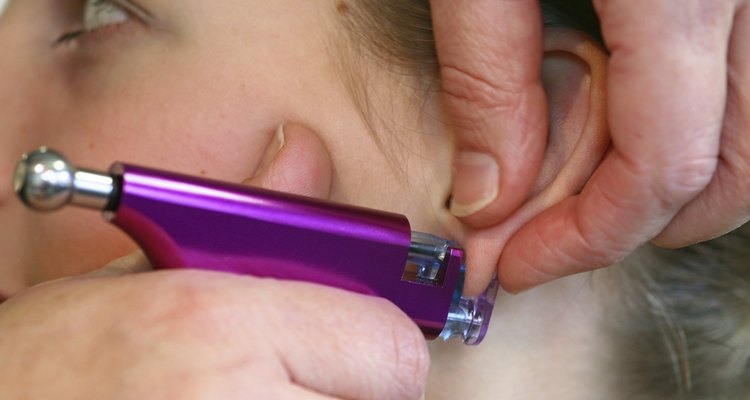
Jaap Uilhoorn/iStock/Getty Images
Getting your ears pierced is a rite of passage for many girls, and even some boys too. The words "ear piercing" may well conjure memories of a trip to the mall, where you sat in a chair in the jewelry shop trying to look brave, watching anxiously while a teenage girl swabbed a piercing gun with alcohol.
Piercing Studs
The studs made to fit in most standard piercing guns are 20-gauge in diameter and just long enough to go through the earlobe. They are usually made of stainless steel and are often gold-plated. Piercing studs are sharper than a normal stud earring to allow them to puncture the lobe. They are held in place by a "butterfly" back that locks onto the jewelry. Because of their short length, they are inappropriate for wear in any part of the body other than the earlobe.
How a Piercing Gun Works
Ear piercing guns are made of plastic with a metal trigger and earring cradle. The earring back goes into the cradle, while the stud itself sits in an adapter built into the shaft. The lobe is placed between the cradle and the adapter.
The person doing the piercing points the end of the stud at a dot marked on the earlobe, and the tension-loaded gun shoots the stud through the skin and into the earring back. The ear is pierced by blunt force, making a piercing gun similar to a staple or nail gun in operation.
Dangers of Piercing Guns
The biggest danger in getting your ears pierced with a gun is that piercing guns cannot be autoclave-sterilized. Only an autoclave, a machine that subjects tools to high-pressure steam at a consistent temperature, can remove all viable microorganisms from their surface. A plastic piercing gun cannot be put into an autoclave. Because the gun uses force to tear through tissue, the possibility of blood spattering onto the gun and pathogens being transmitted from one client to the next is very real.
Needle Piercing
Professional piercers use single-use, autoclaved cannula needles to perform piercings. The needles most commonly used are 18- and 20-gauge. A cannula needle is hollow in the center and beveled on the tip, so that it cuts a very clean incision through tissue.
There is no blunt force trauma from a needle piercing like there is from a gun piercing. A professional piercer autoclaves not only the needles and jewelry, but also his gloves, cotton swabs and gauze pads. He often uses surgical scrub to clean the lobes before and after piercing.
Alternative Jewelry for New Ear Piercings
A professional piercer usually inserts captive bead rings into new ear piercings. Captive bead rings are most commonly made of surgical stainless steel, although titanium and niobium rings are available for those with a steel sensitivity. A captive ring uses pressure to hold a bead in place between two prongs. Because they do not have a back in which dead skin cells and bacteria can become trapped, they are easier to clean than piercing studs.
Related Articles

What Is Bio-Flex Made of for Piercings?

Types of Piercing Needles
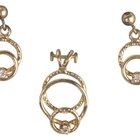
How Long After Piercing Can You Change ...

How to Gauge the Ears Right After the ...
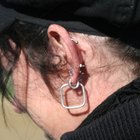
How to Gauge Your Ears with Tapers
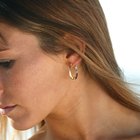
How Long After Piercing Can You Wear ...

Taking Care of Gauged Ears

How Long Do I Have to Wait to Change My ...

How to Open Pierced Ears That Have ...

How Long Before a Nose Ring Hole Closes?
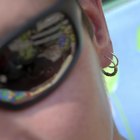
Places to Pierce Your Ear

Facts on Nose Piercings

Professional Way to Clean an Eyebrow ...

Methods of Piercing Your Nose

How to Put in a Curved Nose Ring

How to Put in a Hoop Nose Ring

How Do They Pierce Your Ears With ...

How to Gauge Your Ears Without Tapers

How to Remove a Labret Piercing
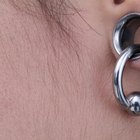
Ear Gauge Problems
References
Writer Bio
Ann Jones has been writing since 1998. Her short stories have been published in several anthologies. Her journalistic work can be found in major magazines and newspapers. She has a Master of Fine Arts in creative writing.
Photo Credits
Jaap Uilhoorn/iStock/Getty Images